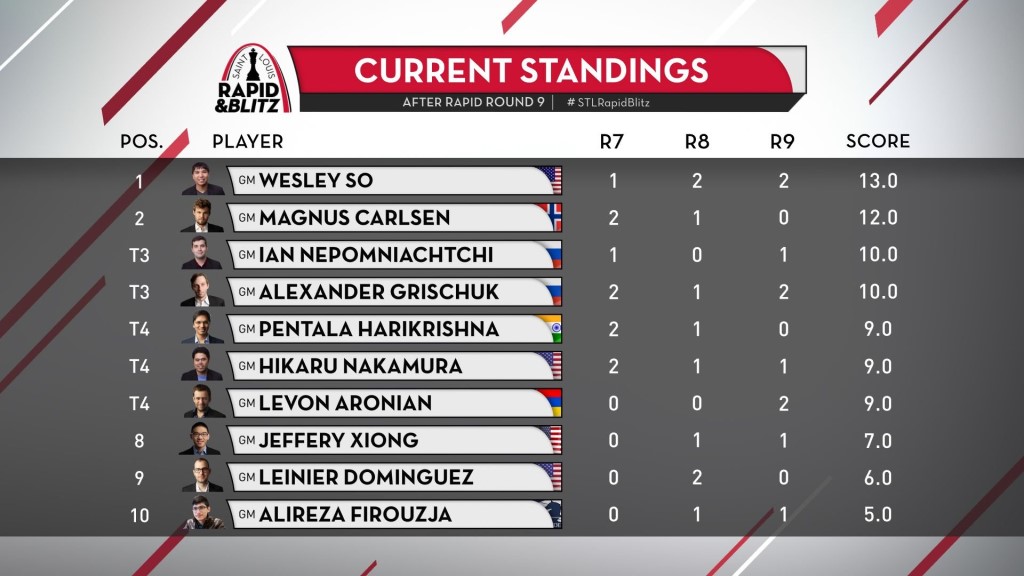


Known for his solid style and his ability in technical positions, Wesley So has managed to consolidate his status as a super-elite player in the last few years. Currently rated 8th, 21st and 4th in the classical, rapid and blitz ratings respectively, So has proven in the past that he has what it takes to win tournaments with accelerated time controls — most notably, the Filipino-born grandmaster won the 2018 “Your Next Move Rapid & Blitz” in Leuven and the 2019 Fischer Random World Championship in Bærum, beating Magnus Carlsen in the final.
Less than a week ago, So beat Carlsen at the Chess 9LX tournament, and he has now leapfrogged the world champion in the standings table of the Saint Louis Rapid & Blitz online event. So won two and drew one on Thursday to remain as the only undefeated player in the field and go into the blitz double round-robin a point ahead of second-placed Carlsen.
Much like So, Alexander Grischuk also finished day three with two wins and a draw, thus climbing up to shared third place. The Russian star defeated Carlsen in round 9, and later commented that his only ambition going into the tournament was to finish in ninth place, because “taking last place is never nice”.
The three-time world blitz champion will get plenty of chances to catch up with the leader, as 18 rounds of 5-minute games (with 3-second increments) will be played on Friday and Saturday to decide the winner of the online event.

Click to enlarge
Four games finished decisively in round 7, with Carlsen continuing his streak of wins with a quick victory over Alireza Firouzja. For Grischuk, Pentala Harikrishna and Hikaru Nakamura, on the other hand, starting the day with a win was a much more difficult task. Nakamura first needed to defend against Levon Aronian’s dangerous-looking attack:
White had already given up his dark-squared bishop on h6 a couple of moves earlier, and now found 19.d5, the strongest continuation according to the engines — there followed 19...fxe4 20.Qg5+ Kh7 21.Nxe4 exd5 22.Nxd6 and Black needs to be very precise in order to defend his extremely vulnerable kingside.
Nakamura was up to the task in defence though, and eventually found himself in an ending in which he had an extra bishop trying to deal with White’s connected passers on the kingside while helping his own majority to move forward on the other flank of the board:
The American converted this position into a 66-move win.
Harikrishna defeated Jeffery Xiong by showing good technique in a knight endgame a pawn up. Grischuk was also a pawn up but in a rook ending against Leinier Dominguez — once the rooks left the board, Dominguez failed to find the correct continuation that would have kept the balance on move 75:
75...Ke6 or 75...Kf6 would have saved the draw, while Black’s 75...Kd4 gave away the game. Grischuk found the right path forward — 76.Kg2 Ke3 77.f4 Ke4 78.Kh3 Kf3 79.Kh4 and the black king would have preferred to be placed on the sixth rank, behind his pawn. Dominguez resigned.
Select an entry from the list to switch between games
On Wednesday, Nepomniachtchi had lost in 21 moves against Xiong after incorrectly going for a pawn capture on move 10. In round 8, he found himself in a lost position after 15 moves against Dominguez:
The Russian grandmaster mishandled a Caro-Kann Defence and was in deep trouble after 16.Ne4, as there was no way to prevent White from giving a check from d6, leaving the black king uncastled with the queens still on the board. The game continued 16...Bc6 17.Nd6+ Ke7 18.Be3 Nf4 19.Qd2 Nh3+ 20.Kf1 (20.gxh3 is also possible, but inaccurate) Bd5:
Dominguez got to end the game with a small tactical shot — 21.Qxd5 and Black resigned due to the coming knight fork from f5.
So showed good technique in a bishop v knight endgame to inflict Aronian’s second consecutive loss, while Carlsen saved a draw from an inferior rook endgame against Xiong. At that point, the world champion was still leading the standings table, a point ahead of So.
Coming from having won four in a row before barely saving a draw, Carlsen decided it was time to take some risks with the black pieces against Grischuk. The world champion chose the Dragondorf variation of the Sicilian, which mixes elements from the Dragon and the Najdorf, both fighting variations in their own right. The Norwegian gave up an exchange on move 19:
Carlsen’s 19...Rxc3 was overly optimistic, as White kept things under control on the queenside with 20.bxc3 Qe6 21.Kb2 Rc8 (21...d5 was more to the point) 22.Ba5. Now 22...d5 came a bit too late:
White grabbed the initiative with 23.Qa7 Ba8 24.Nxa6 Bf8 and the bothersome 25.Nc7. Carlsen kept trying to find defensive resources until move 46, when he finally conceded defeat.
So leapfrogged the world champion in the standings table by getting the better of Harikrishna in a knight ending:
Black correctly calculated that he could leave the a-pawn undefended with 61...Nd5+. After 62.Kxa4 Nf4 63.Nc3 Ng2 64.Ne2 f4 65.Kb4 Nxh4 66.Ng1, So gave up the knight with 66...Nxf3, forcing Harikrishna to resign three moves later, as his knight was by no means enough to stop Black’s connected passers.
Meanwhile, former co-leader Aronian recovered from his two consecutive losses by defeating Dominguez with the white pieces, thus ending the rapid section with an even score.

Click to enlarge